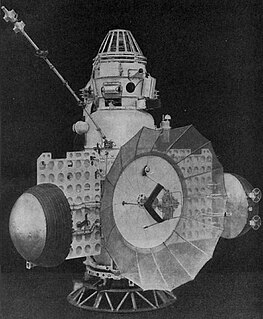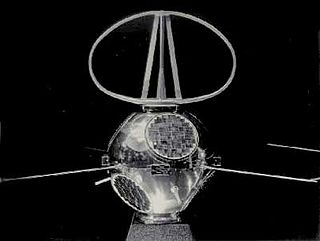| Mission type | Venus lander |
|---|---|
| Operator | OKB-1 |
| Harvard designation | 1962 Alpha Tau 1 [1] |
| COSPAR ID | 1962-043A |
| SATCAT no. | 381 |
| Mission duration | Launch failure |
| Spacecraft properties | |
| Spacecraft type | 2MV-1 |
| Manufacturer | OKB-1 |
| Launch mass | 6,500 kg (14,300 lb) |
| Start of mission | |
| Launch date | 1 September 1962, 02:12:30 UTC |
| Rocket | Molniya 8K78 s/n T103-13 |
| Launch site | Baikonur 1/5 |
| End of mission | |
| Decay date | 6 September 1962 |
| Orbital parameters | |
| Reference system | Geocentric |
| Regime | Low Earth (achieved) Heliocentric (intended) |
| Eccentricity | 0.00981 |
| Perigee altitude | 180 kilometres (110 mi) |
| Apogee altitude | 310 kilometres (190 mi) |
| Inclination | 64.9 degrees |
| Period | 89.4 minutes |
| Epoch | 1 September 1962 |
Venera 2MV-1 No.2, [2] [1] also known as Sputnik 20 in the Western world, was a Soviet spacecraft, which was launched in 1962 as part of the Venera programme. Due to a problem with its upper stage it failed to leave low Earth orbit, and reentered the atmosphere a few days later. [3] It was the second of two Venera 2MV-1 spacecraft, both of which failed to leave Earth orbit. The previous mission, Venera 2MV-1 No.1, was launched several days earlier. [1]
Venera 2MV-1 No.2 was launched at 02:12:30 UTC on 1 September 1962, atop a Molniya 8K78 carrier rocket flying from Site 1/5 at the Baikonur Cosmodrome. [2] The lower stages of the rocket operated nominally, injecting the fourth stage and payload into a low Earth orbit. Following a coast phase, the upper stage was to have ignited around sixty-one minutes and thirty seconds after launch, in order to place the spacecraft into heliocentric orbit. The ignition command did not reach the engine, however, and the fuel valves did not open, so the upper stage failed to ignite leaving the payload in geocentric orbit. [4] It reentered the atmosphere on 6 September 1962, five days after it had been launched. [5]
The designations Sputnik 24, [6] and later Sputnik 20, were used by the United States Naval Space Command to identify the spacecraft in its Satellite Situation Summary documents, since the Soviet Union did not release the internal designations of its spacecraft at that time, and had not assigned it an official name due to its failure to depart Earth orbit. [7]
Tyazhely Sputnik,, also known by its development name as Venera 1VA No.1, and in the West as Sputnik 7, was a Soviet spacecraft, which was intended to be the first spacecraft to explore Venus. Due to a problem with its upper stage it failed to leave low Earth orbit. In order to avoid acknowledging the failure, the Soviet government instead announced that the entire spacecraft, including the upper stage, was a test of a "Heavy Satellite" which would serve as a launch platform for future missions. This resulted in the upper stage being considered a separate spacecraft, from which the probe was "launched", on several subsequent missions.
Venera 2MV-1 No.1, also known as Sputnik 19 in the West, was a Soviet spacecraft, which was launched in 1962 as part of the Venera programme.
Mars 2MV-4 No.1 also known as Sputnik 22 in the West, was a Soviet spacecraft, which was launched in 1962 as part of the Mars programme, and was intended to make a flyby of Mars, and transmit images of the planet back to Earth. Due to a problem with the rocket which launched it, it was destroyed in low Earth orbit. It was the first of two Mars 2MV-4 spacecraft to be launched, the other being the Mars 1 spacecraft which was launched eight days later.
Mars 2MV-3 No.1 also known as Sputnik 24 in the West, was a Soviet spacecraft, which was launched in 1962 as part of the Mars program, and was intended to land on the surface of Mars. Due to a problem with the rocket which launched it, it did not depart low Earth orbit, and it decayed several days later. It was the only Mars 2MV-3 spacecraft to be launched.
Luna E-6 No.2, also identified as No.1, and sometimes known in the West as Sputnik 25, was a Soviet spacecraft which launched in 1963, but was placed into a useless orbit due to a problem with the upper stage of the rocket that launched it. It was a 1,500-kilogram (3,300 lb) Luna E-6 spacecraft, the first of twelve to be launched. It was intended to be the first spacecraft to perform a soft landing on the Moon, a goal which would eventually be accomplished by the final E-6 spacecraft, Luna 9.

Venera 2, also known as 3MV-4 No.4 was a Soviet spacecraft intended to explore Venus. A 3MV-4 spacecraft launched as part of the Venera programme, it failed to return data after flying past Venus.
Venera 2MV-2 No.1, also known as Sputnik 21 in the West, was a Soviet spacecraft, which was launched in 1962 as part of the Venera programme, and was intended to make a flyby of Venus. Due to a problem with the rocket which launched it, it failed to leave low Earth orbit, and reentered the atmosphere a few days later. It was the second Venera 2MV-2 spacecraft, both of which failed to leave Earth orbit.
Kosmos 1, also known as DS-2 No.1 and occasionally in the West as Sputnik 11 was a technology demonstration and ionospheric research satellite launched by the Soviet Union in 1962. It was the first satellite to be designated under the Kosmos system, and the first spacecraft launched as part of the Dnepropetrovsk Sputnik programme to successfully reach orbit. Its primary missions were to measure the performance of its carrier rocket, and to conduct research into the ionosphere.
Kosmos 295, known before launch as DS-P1-Yu No.29, was a Soviet satellite which was launched in 1969 as part of the Dnepropetrovsk Sputnik programme. It was a 325-kilogram (717 lb) spacecraft, which was built by the Yuzhnoye Design Bureau, and was used as a radar calibration target for anti-ballistic missile tests.
Kosmos 455, known before launch as DS-P1-Yu No.54, was a Soviet satellite which was launched in 1971 as part of the Dnepropetrovsk Sputnik programme. It was a 325-kilogram (717 lb) spacecraft, which was built by the Yuzhnoye Design Bureau, and was used as a radar calibration target for anti-ballistic missile tests.
Kosmos 467, known before launch as DS-P1-Yu No.45, was a Soviet satellite which was launched in 1971 as part of the Dnepropetrovsk Sputnik programme. It was a 325-kilogram (717 lb) spacecraft, which was built by the Yuzhnoye Design Bureau, and was used as a radar calibration target for anti-ballistic missile tests.
Kosmos 472, known before launch as DS-P1-Yu No.52, was a Soviet satellite which was launched in 1972 as part of the Dnepropetrovsk Sputnik programme. It was a 250-kilogram (550 lb) spacecraft, which was built by the Yuzhnoye Design Bureau, and was used as a radar calibration target for anti-ballistic missile tests.
Kosmos 481, known before launch as DS-P1-Yu No.46, was a Soviet satellite which was launched in 1972 as part of the Dnepropetrovsk Sputnik programme. It was a 375-kilogram (827 lb) spacecraft, which was built by the Yuzhnoye Design Bureau, and was used as a radar calibration target for anti-ballistic missile tests.
Kosmos 498, known before launch as DS-P1-Yu No.56, was a Soviet satellite which was launched in 1972 as part of the Dnepropetrovsk Sputnik programme. It was a 325-kilogram (717 lb) spacecraft, which was built by the Yuzhnoye Design Bureau, and was used as a radar calibration target for anti-ballistic missile tests.
Kosmos 501, known before launch as DS-P1-Yu No.50, was a Soviet satellite which was launched in 1972 as part of the Dnepropetrovsk Sputnik programme. It was a 250-kilogram (550 lb) spacecraft, which was built by the Yuzhnoye Design Bureau, and was used as a radar calibration target for anti-ballistic missile tests.
Kosmos 261, also known as DS-U2-GK No.1, was a Soviet satellite which was launched in 1968 as part of the Dnepropetrovsk Sputnik programme. It was a 347-kilogram (765 lb) spacecraft, which was built by the Yuzhnoye Design Bureau, and was used to study the density of air in the upper atmosphere, and investigate aurorae.
Kosmos 348, also known as DS-U2-GK No.2, was a Soviet satellite which was launched in 1970 as part of the Dnepropetrovsk Sputnik programme. It was a 357-kilogram (787 lb) spacecraft, which was built by the Yuzhnoye Design Bureau, and was used to study the density of air in the upper atmosphere, and investigate aurorae.

LOFTI-1 was an American satellite which was launched in 1961 and operated by the United States Navy and Naval Research Laboratory. It was used to conduct research into the propagation of very low frequency radio signals in the ionosphere, and to investigate if these signals could be received by submarines. A 136.17 MHz transmitter was used for this investigation.
Kosmos 96, or 3MV-4 No.6, was a Soviet spacecraft intended to explore Venus. A 3MV-4 spacecraft launched as part of the Venera programme, Kosmos 96 was to have made a flyby of Venus; however, due to a launch failure, it did not depart low Earth orbit.
Kosmos 167, or 4V-1 No.311, was a 1967 Soviet spacecraft intended to explore Venus. A 4V-1 spacecraft launched as part of the Venera programme, Kosmos 167 was intended to land on Venus, but never departed low Earth orbit due to a launch failure.
| This article about one or more spacecraft of the Soviet Union is a stub. You can help Wikipedia by expanding it. |